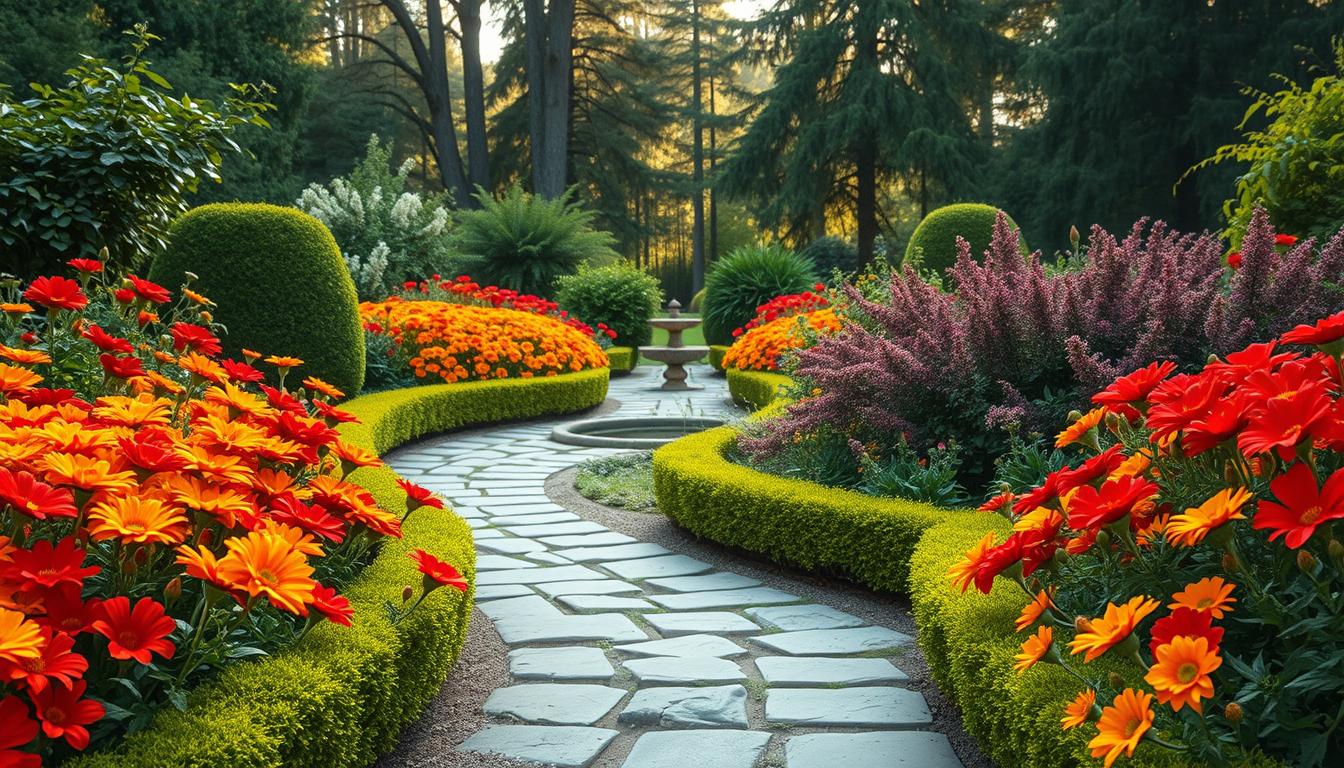Gardening brings joy and a sense of accomplishment, even when things don’t go as planned. My first attempt at growing lavender ended in failure, but it sparked a passion that grew into expertise. Over the years, I’ve learned that every space, no matter how small, can thrive with the right approach.
This guide is for everyone, whether you have a sprawling backyard or a cozy urban balcony. It’s about understanding your plants, maximizing your space, and creating a harmonious environment. Mistakes are part of the journey, and they’ve helped me refine my methods over time.
Trusted resources like the RHS website and Gardeners’ World magazine have been invaluable. They offer practical advice on sun tracking, zoning, and wildlife-friendly practices. Let’s dive in and transform your outdoor area into a thriving haven.
Key Takeaways
- Gardening is a rewarding journey, even with initial setbacks.
- Every space, big or small, can be optimized for plants.
- Learning from mistakes leads to better results over time.
- Trusted resources like RHS and Gardeners’ World provide reliable guidance.
- Practical tips include sun tracking, zoning, and supporting wildlife.
Introduction to Garden Design
Transforming a small balcony into a lush green space sparked my love for gardening. Over the past four years, I’ve learned that every space, no matter the size, holds potential. My journey began with a few pots and evolved into creating an L-shaped garden measuring 6m x 16m. It’s been a rewarding experience, filled with lessons and growth.
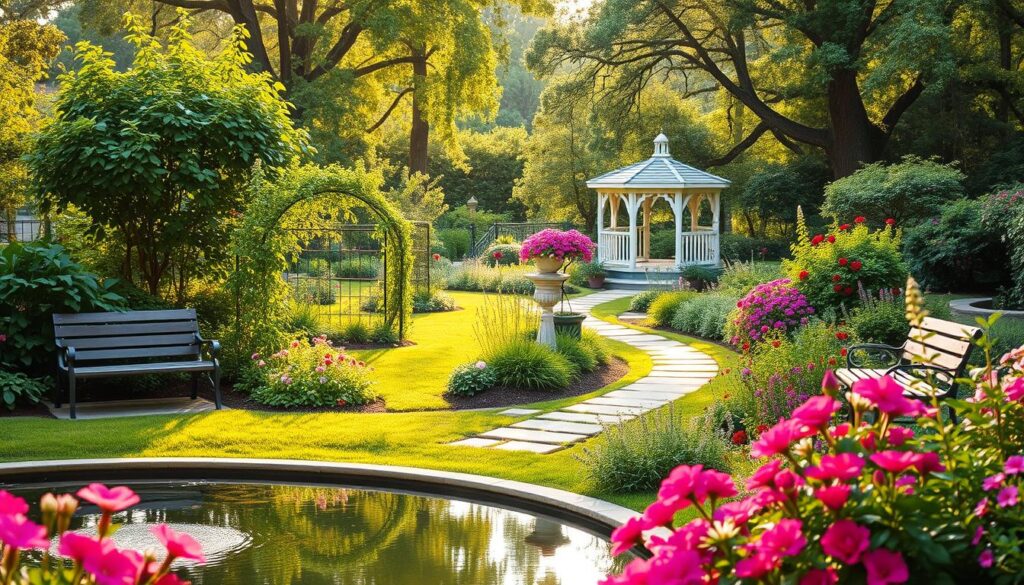
Balancing aesthetics with functionality is key, whether you’re working with a compact balcony or a sprawling backyard. In smaller spaces, vertical designs and multi-functional features can maximize impact. Larger areas allow for creativity, but it’s essential to plan thoughtfully to avoid overwhelming the space.
One regret I’ve learned from is opting for quick fixes like plastic grass. While it might seem convenient, it lacks the natural beauty and benefits of real plants. Gardening is about patience and nurturing, not shortcuts.
The growing interest in gardening is evident, with waiting lists for allotments becoming common. This surge reflects a desire to connect with nature and create personal green havens. Whether you’re a beginner or an experienced gardener, understanding your space is crucial.
Key concepts like microclimates, aspect analysis, and phased implementation can guide your journey. These tools help you work with your environment, ensuring your garden thrives. Let’s explore how to make the most of your outdoor space, step by step.
Understanding Your Garden Space
Understanding your outdoor space is the first step to creating a thriving green area. Every corner has unique characteristics that influence what you can grow. From sunlight patterns to soil quality, these factors shape your garden’s potential.
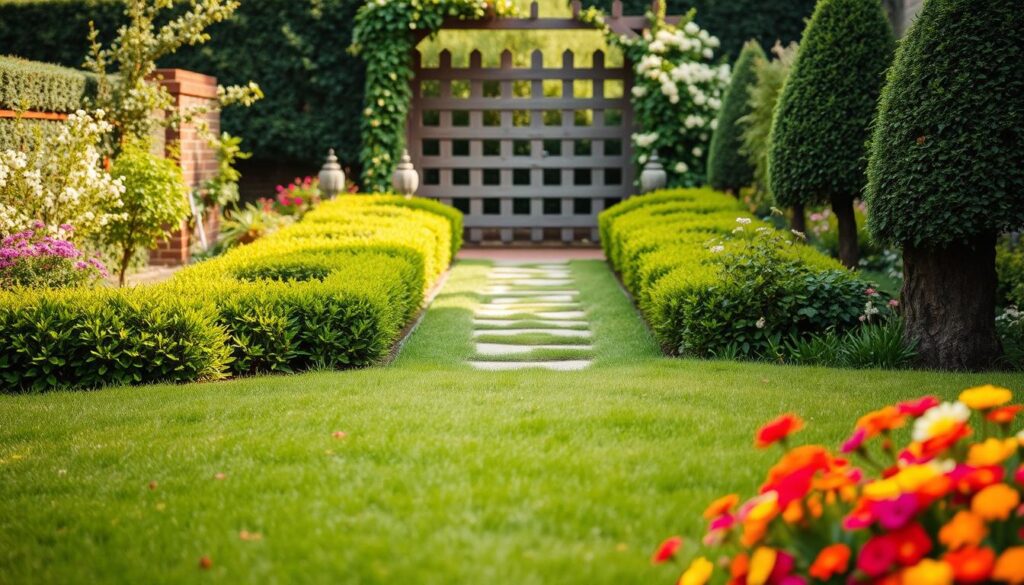
Assessing Sun Exposure
Sunlight is crucial for plant growth. Observe your space throughout the day to identify sunny and shaded spots. Some plants, like blueberries, thrive in partial shade, while others, such as lavender, need full sun.
Evaluating Wind and Shelter
Wind can impact your garden’s health. Strong gusts may damage delicate plants. Consider natural barriers like trees or install windbreaks to create sheltered areas. This ensures your beds remain protected.
Analyzing Soil Type
Healthy soil is the foundation of a successful garden. Test your soil’s pH to determine its acidity or alkalinity. For example, rhododendrons prefer acidic soil, while hydrangeas adapt to different pH levels.
Over the years, I transformed my garden from plastic grass to worm-rich earth. Mulching improved my clay soil, enhancing its texture and water retention. Raised beds are another excellent solution for problematic soils, offering better drainage and control.
For water retention, consider plant choices. Mediterranean plants like rosemary thrive in dry conditions, while hydrangeas need consistent moisture. A “bulb lasagne” pot technique, layering bulbs for staggered blooms, adds beauty and efficiency to small spaces.
Sketching Your Garden Layout
Starting with a simple sketch can unlock endless possibilities for your outdoor space. A rough draft helps you visualize your ideas and identify potential challenges early on. Begin by noting immovable features like patios, mature trees, or existing structures. These elements serve as anchors for your plan.
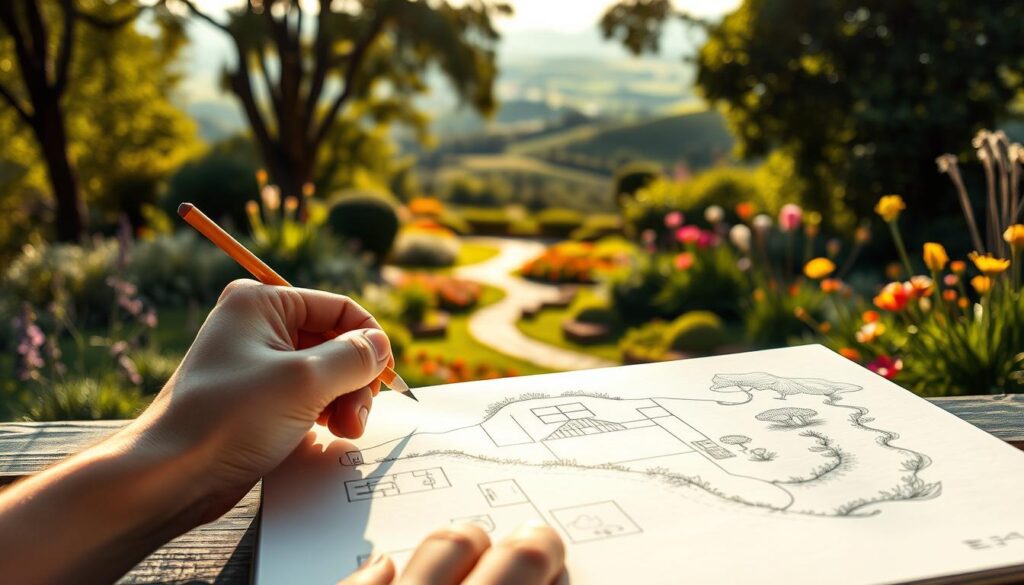
As your sketch evolves, consider the “garden rooms” philosophy. This approach divides your space into functional zones, such as a potting area, family seating, or a vegetable patch. Each “room” serves a purpose, creating a harmonious flow throughout the area. This method works for both large yards and small balconies.
One common mistake is making permanent decisions too quickly. For example, installing sleeper borders might seem like a good idea at first, but they can limit flexibility later. Instead, opt for temporary solutions that allow you to adapt as your needs change.
Sketching is a versatile tool, regardless of your space’s size. For compact areas, focus on vertical designs and multi-functional features. Even a small balcony can transform into a green oasis with thoughtful planning. Remember, your sketch is a starting point, not a final blueprint.
By documenting your ideas on paper, you can refine your vision and avoid costly mistakes. A well-executed plan ensures every inch of your space is utilized effectively. Whether you’re working with a sprawling backyard or a cozy corner, sketching is the first step toward creating a space you’ll love.
Zoning Your Garden
Creating distinct zones in your outdoor area can transform it into a functional and beautiful retreat. By dividing your space into specific sections, you can cater to different needs and activities. Whether you’re planning a family play area or a vegetable patch, zoning ensures every part of your garden serves a purpose.
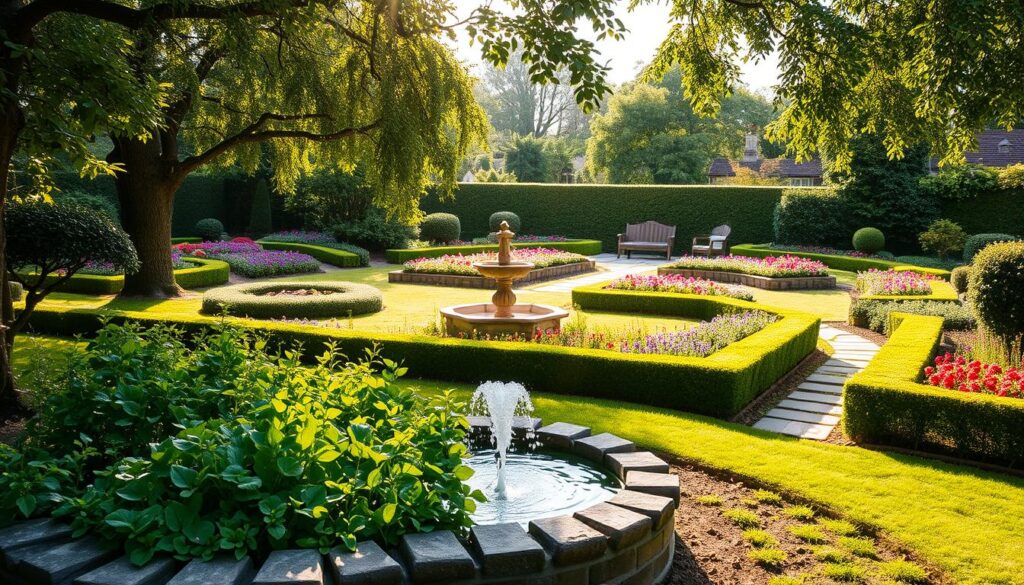
One effective way to approach zoning is by using a 5-zone breakdown. This method includes areas for potting, seating, lawn, sunny patio, and vegetables. Each zone can be tailored to your lifestyle, ensuring your outdoor space works for you.
“A well-zoned garden is like a well-organized house—every area has a purpose, and the flow feels natural.”
Here’s a breakdown of the 5 zones and their functions:
| Zone | Purpose |
|---|---|
| Potting Area | Space for planting and potting plants |
| Seating Area | Relaxation and socializing |
| Lawn | Open space for play or lounging |
| Sunny Patio | Ideal for Mediterranean plants and seating |
| Vegetable Patch | Growing fresh produce |
Prioritize your needs when planning these zones. For example, families might focus on play areas, while avid gardeners may dedicate more space to vegetables. Over time, zones can transition to meet changing needs—like turning a veg patch into a play area as your family grows.
Maximize sunny zones for plants like lavender or rosemary, and create sheltered dining areas near the house for convenience. In constrained spaces, vertical designs like living walls can add greenery without taking up ground space.
Choosing the Right Plants
The right plants can transform any space into a vibrant, thriving environment. Whether you’re working with a sunny patio or a shaded corner, selecting the perfect plant ensures your outdoor area flourishes. It’s not just about aesthetics—understanding your space’s conditions is key to long-term success.
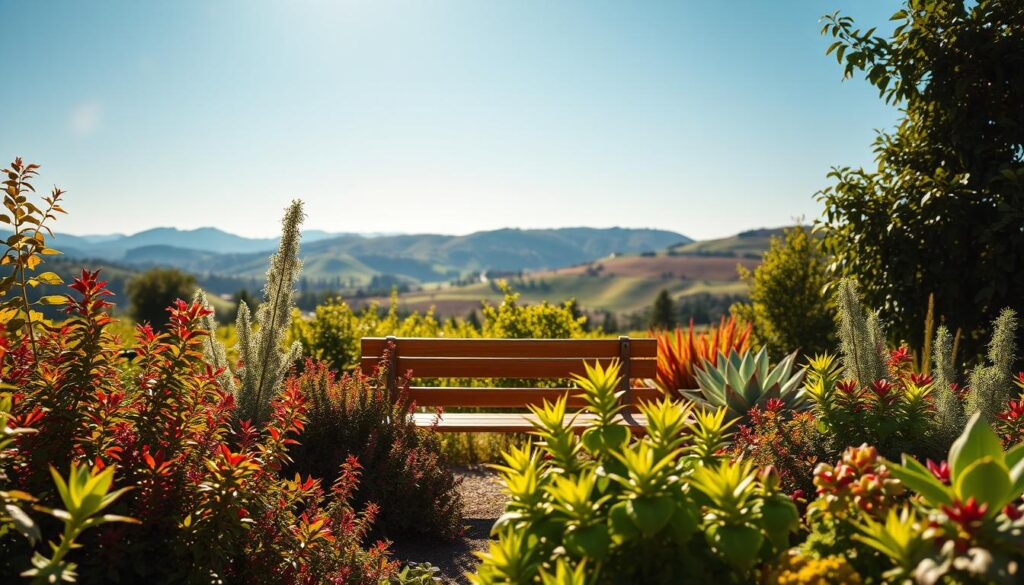
Selecting Plants for Sun and Shade
Sunlight plays a crucial role in plant health. Observe your space to identify sunny and shaded areas. Lavender thrives in full sun, while ferns prefer cooler, shaded spots. Matching plants to their ideal light conditions ensures they grow strong and healthy.
Considering Soil and Water Needs
Healthy soil is the foundation of a thriving garden. Test your soil’s pH to determine its acidity or alkalinity. For acid-loving plants like blueberries, use ericaceous compost. In drought-prone areas, implement drip irrigation to conserve water and keep your beds hydrated.
Position moisture-loving plants near downspouts to take advantage of natural water flow. Rainwater harvesting systems are another eco-friendly way to manage resources. Over time, these practices create a sustainable and efficient outdoor space.
“A well-chosen plant not only enhances beauty but also supports the ecosystem around it.”
For example, after amending my clay soil, my lavender thrived for three years. This success story highlights the importance of tailoring your approach to your environment. With thoughtful planning, your plants will flourish, bringing joy and life to your space.
For more tips on starting your gardening journey, check out this beginner’s guide.
Incorporating Trees and Shrubs
Incorporating trees and shrubs into your outdoor area can elevate its beauty and functionality. These elements add structure, shade, and a sense of permanence to your garden. Whether you have a sprawling yard or a compact balcony, there’s a way to include them.
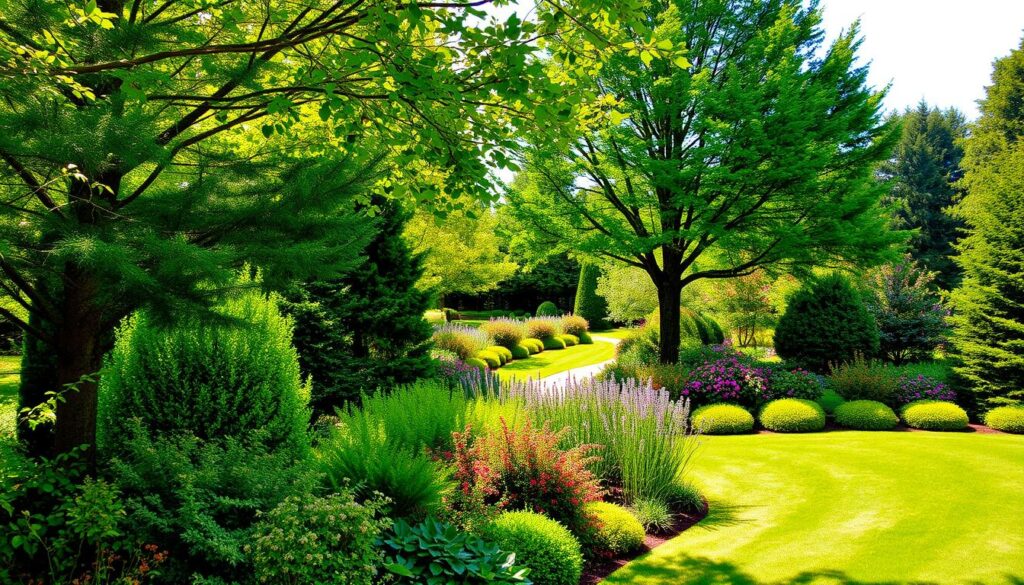
For smaller spaces, potted trees are a fantastic option. They allow for seasonal rotation, ensuring your area always looks fresh. Dwarf varieties, like acers or olive trees, are perfect for urban settings. They provide the same benefits without overwhelming the area.
One creative idea is reusing a potted spruce as a Christmas tree. After the holidays, it can continue to thrive outdoors. This approach is both eco-friendly and practical, adding greenery year-round.
Crab apple trees are another excellent choice. They not only enhance your garden’s aesthetics but also support wildlife. Birds and pollinators are drawn to their blossoms and fruit, creating a vibrant ecosystem.
However, be cautious with invasive root systems. Planting large trees too close to structures can cause damage over the years. Research your choices carefully to avoid future issues.
By thoughtfully selecting and placing trees and shrubs, you can transform your outdoor space into a lush, inviting retreat. Whether you’re adding a single statement piece or creating a layered landscape, these elements bring life and character to any area.
Designing with Borders and Beds
Crafting a beautiful outdoor space starts with thoughtful planning and creative use of borders and beds. These elements define the structure of your area, adding both function and visual appeal. Whether you’re working with a small plot or a sprawling yard, borders and beds can transform your space into a cohesive and inviting retreat.

One effective strategy is layering plants by height. Taller plants like acanthus work well at the back, while shorter varieties like alyssum shine in the front. This creates depth and ensures every plant gets the attention it deserves. For a dynamic look, mix perennials and annuals. Perennials provide consistency, while annuals add seasonal bursts of color.
When planning your beds, consider the aesthetic of curved versus straight borders. Curved lines soften the look, creating a natural flow. Straight borders, on the other hand, offer a clean, structured appearance. Both styles have their merits, so choose one that complements your overall vision.
If you’re incorporating a pond, safety is crucial, especially with toddlers. Secure the edges with sturdy materials and consider adding a barrier. This ensures your water feature is both beautiful and safe for little ones.
“Pollinator-friendly plants not only enhance your garden’s beauty but also support local ecosystems.”
To attract pollinators, include plants like lavender, coneflowers, and salvia in your borders. These flowers are not only stunning but also beneficial for bees and butterflies. By thoughtfully selecting and arranging your plants, you can create a space that’s both beautiful and eco-friendly.
Remember, your beds and borders are the foundation of your outdoor area. With careful planning and creative touches, you can turn any space into a thriving, picturesque retreat.
Using Pots and Containers
Pots and containers offer endless possibilities for transforming your outdoor space. Whether you have a small balcony or a sprawling patio, these versatile tools allow you to create a dynamic and ever-changing display. From seasonal rotations to vertical stacking, the options are limitless.
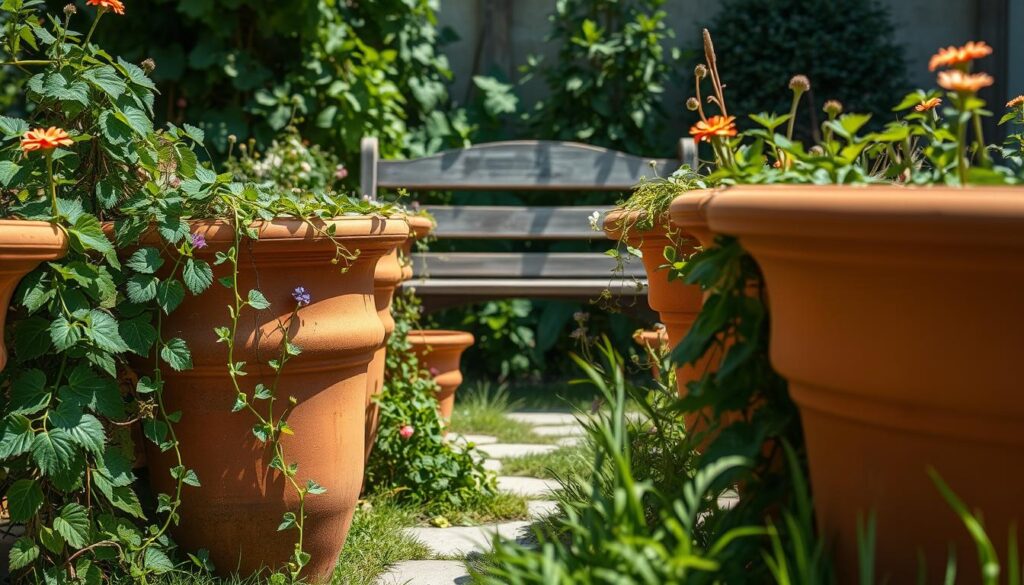
One of the joys of using pots is the ability to rotate seasonal displays. Start with spring bulbs like tulips and daffodils, then transition to summer annuals like petunias and marigolds. This keeps your patio vibrant and fresh throughout the year.
For plants with specific soil needs, pots are a game-changer. Citrus trees, for example, thrive in acidic soil mixes that can be tailored in containers. This ensures your plants get the nutrients they need, even if your garden soil isn’t ideal.
“Containers allow you to bring nature closer to your home, no matter the size of your outdoor area.”
If you’re working with a rooftop garden, weight considerations are crucial. Lightweight materials like fiberglass or resin are excellent choices. They reduce the load while still providing a sturdy base for your plants.
For small patios, vertical stacking techniques maximize space. Use tiered planters or wall-mounted containers to create a lush, green wall. This not only saves ground area but also adds visual interest.
Busy gardeners will appreciate self-watering containers. These innovative pots ensure your plants stay hydrated, even when you’re short on time. They’re perfect for maintaining a thriving outdoor area with minimal effort.
With thoughtful planning, pots and containers can turn any space into a flourishing retreat. Whether you’re experimenting with seasonal displays or optimizing a small patio, these tools make gardening accessible and enjoyable.
Adding Structures and Features
Adding structures and features can elevate your outdoor area into a functional and beautiful retreat. These elements not only enhance aesthetics but also create a sense of purpose and organization. Whether you’re working with a small balcony or a spacious yard, thoughtful additions can transform your space.
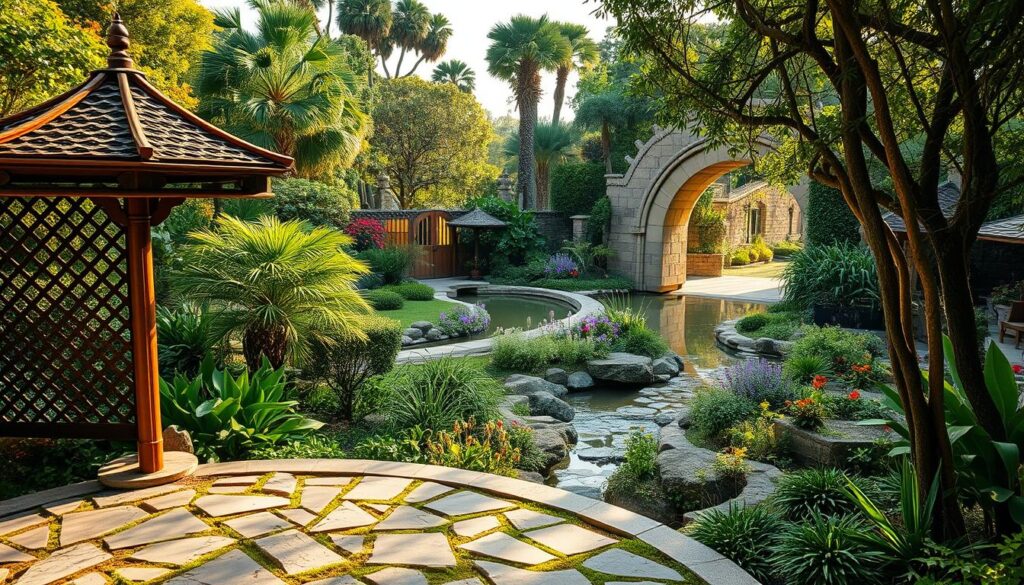
Installing Trellises and Arbors
Trellises and arbors are versatile additions that add vertical interest to your area. They provide support for climbing plants like roses or clematis, creating a lush, green backdrop. Arbors can also serve as entryways, marking transitions between different zones in your space.
For smaller areas, compact trellises are ideal. They maximize vertical space without overwhelming the area. In larger gardens, arbors can create shaded walkways, adding both beauty and functionality.
Including Water Features
Water features bring a sense of tranquility and attract wildlife to your garden. From ponds to fountains, these elements add movement and sound, creating a relaxing atmosphere. A well-placed pond can even become a focal point, drawing in dragonflies and other beneficial insects.
When choosing a water feature, consider the following options:
| Type | Benefits |
|---|---|
| Preformed Ponds | Easy to install, durable, and low maintenance. |
| Liner Ponds | Customizable shape and size, ideal for unique designs. |
| Solar-Powered Fountains | Eco-friendly, no wiring required, and cost-effective. |
Place bird baths near shrubs to provide a safe spot for birds to drink and bathe. To prevent mosquito breeding, ensure water is moving with a fountain or pump. For families with young children, shallow features are a safer option.
“A well-designed water feature not only enhances your garden but also supports local wildlife.”
By incorporating these structures and features, you can create a dynamic and inviting outdoor space. Whether it’s a trellis covered in blooms or a bubbling fountain, these additions bring life and character to your area.
Planning for Wildlife
Creating a haven for wildlife starts with thoughtful choices in your outdoor space. By incorporating native plants and eco-friendly features, you can support local ecosystems and attract a variety of creatures. Whether you have a sprawling yard or a cozy balcony, these tips will help you make a difference.
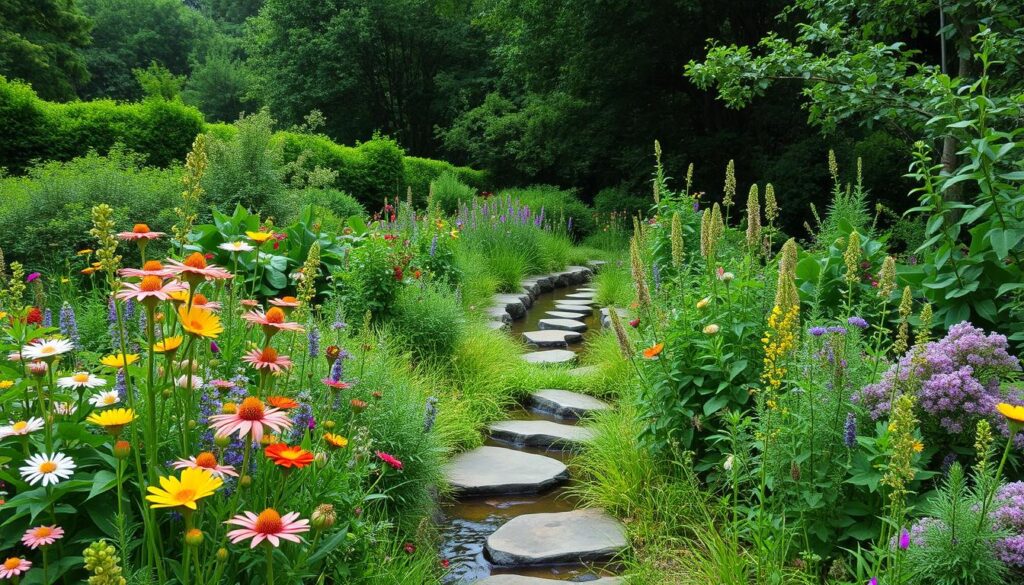
Start by choosing native plants. These species are adapted to your region’s climate and provide essential food and shelter for local wildlife. For example, milkweed supports monarch butterflies, while native shrubs like elderberry attract birds and pollinators.
Another simple yet impactful idea is building insect hotels. Use recycled materials like bamboo, wood, and bricks to create cozy shelters for bees and other beneficial insects. Place them in sunny spots near flowering plants for maximum effectiveness.
For larger spaces, consider installing a hedgehog highway. These small gaps in fences allow hedgehogs to roam freely, helping them find food and mates. It’s a small change that can make a big difference for these adorable creatures.
Bird feeders are another excellent addition. Place them near trees or shrubs to provide safety from predators. Choose feeders with different seed types to attract a variety of birds. Remember to clean them regularly to prevent disease.
Finally, include night-blooming flowers like evening primrose or moonflower. These plants attract moths and other nocturnal pollinators, adding another layer of life to your space.
“A wildlife-friendly garden not only supports local ecosystems but also brings joy and wonder to your daily life.”
Here’s a quick guide to get started:
| Feature | Benefit |
|---|---|
| Native Plants | Support local wildlife and require less maintenance. |
| Insect Hotels | Provide shelter for bees and other beneficial insects. |
| Hedgehog Highways | Help hedgehogs move freely between gardens. |
| Bird Feeders | Attract a variety of birds and provide year-round food. |
| Night-Blooming Flowers | Support nocturnal pollinators like moths. |
By making these small changes, you can transform your garden into a thriving habitat for wildlife. Every effort counts, and the rewards are well worth it.
Maintaining Your Garden
A well-maintained outdoor space requires consistent care throughout the year. From seasonal pruning to winterizing your irrigation system, each task plays a vital role in keeping your area vibrant and functional. With a little time and effort, you can ensure your plants thrive in every season.
Start with seasonal pruning schedules for common shrubs. Regular trimming promotes healthy growth and prevents overgrowth. For example, prune hydrangeas in late winter or early spring to encourage new blooms. This simple step keeps your plants looking their best.
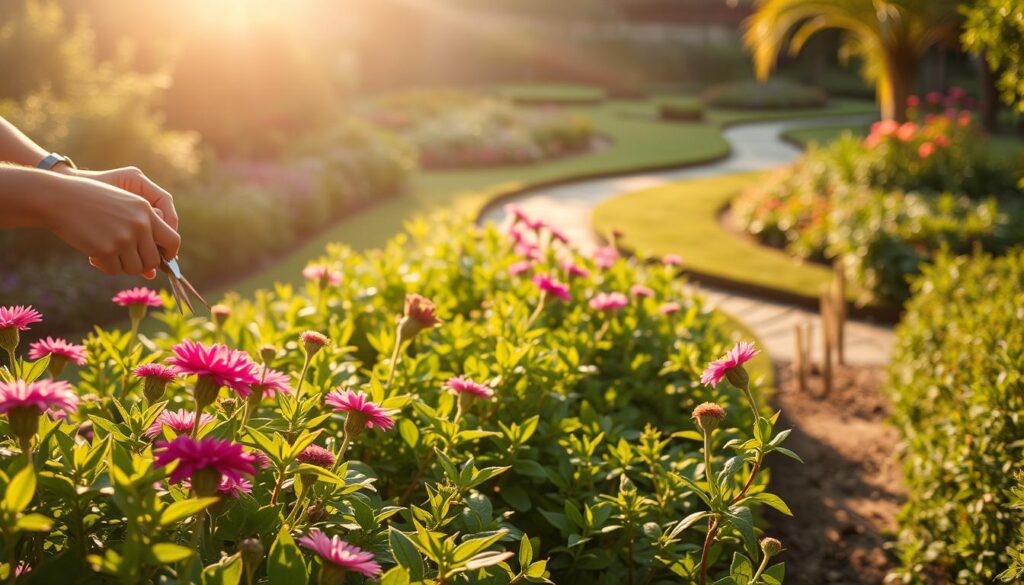
Mulching is another essential task. It suppresses weeds, retains moisture, and improves soil health. Apply a layer of organic mulch, like wood chips or straw, around your plants each spring. This not only protects your soil but also adds a polished look to your space.
Winterizing potted plants is crucial to protect them from frost. Move containers to sheltered areas or wrap them in burlap. For added insulation, group pots together and cover them with a frost cloth. These steps ensure your plants survive the colder months.
Don’t forget your irrigation system. Proper winterization prevents damage from freezing temperatures. Follow these steps to safeguard your system:
| Step | Action |
|---|---|
| 1 | Turn off the water supply to the system. |
| 2 | Drain all pipes and sprinklers to remove excess water. |
| 3 | Insulate above-ground components with foam covers. |
“A well-maintained garden is a reflection of the care and time you invest in it.”
Finally, keep your tools in top shape. Sharpen blades, oil moving parts, and clean surfaces regularly. A simple maintenance calendar ensures your tools are ready whenever you need them. This saves time and extends the life of your equipment.
By following these steps, you can maintain a thriving outdoor space that evolves with the seasons. Whether it’s pruning, mulching, or winterizing, each task contributes to a beautiful and functional area you’ll enjoy all year long.
Conclusion
The beauty of gardening lies in its ability to evolve over time. Embrace the “learn by doing” philosophy—every mistake is a step toward mastery. Keep a journal to track your progress seasonally. This helps you understand what works best for your space.
Connecting with local gardening communities can inspire and support your journey. Share tips, swap plants, and learn from others’ experiences. Avoid quick-fix solutions; they often lead to disappointment. Instead, focus on sustainable practices that nurture your garden for the long term.
Imagine your outdoor area in five years. With patience and care, it can transform into a thriving haven. Whether you’re starting small or dreaming big, every effort counts. Your garden is a reflection of your dedication and creativity—let it grow with you.

